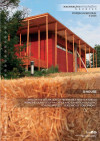Suchergebnisse
Bio-Minimum-Lubrication
Entwicklung eines Minimalmengenkühlschmier-Systems für den Einsatz in der zerspanenden Metallbearbeitung unter Verwendung von Emulsion auf Basis nachwachsender Rohstoffe
Wood Plastic Composites
Förderungen in der Kreislaufwirtschaft
In diesem Projekt wurden mittels online-Recherchen und Expert:innen-Befragungen Förderungsmöglichkeiten für Projekte und Maßnahmen im Bereich Kreislaufwirtschaft gesammelt und in eine Datenbank überführt, die zur Suche geeigneter Förderungsschienen dient.
Green Recovery of Metals (GRecoMet)
Die kritischen Rohstoffe aus Sekundärressourcen wie Müllverbrennungsschlacken und -aschen werden mit Bioleaching Methoden herausgelöst und mit innovativen Verfahren aufkonzentriert und zurückgewonnen. Die Aufkonzentrierung erfolgt über Biosorption mit Reststoffen aus der lebensmittelverarbeitenden Industrie, Rhizofiltration mit Sumpfpflanzen, Biosorption mit Algen und spezifische Biosorption mit biogenen Polymeren. Aus diesen Systemen werden die kritischen Metalle mit adaptierten hydro- und pyrometallurgischen Methoden wiedergewonnen und aufgereinigt. Alle entwickelten Technologien werden in einem prozessintegrativen Versuch in Kleintechnikumsgröße über ein Jahr getestet. Die Ergebnisse des Projekts werden nach technologischen, ökologischen, ökonomischen und sozio-ökonomischen Kriterien evaluiert und zu ersten Plänen für ein zukünftiges Scale-Up herangezogen.
Die Papierfabrik im Jahr 2030
Papierfabrik im Jahr 2030 als integrierter Bestandteil einer nachhaltigen Wirtschaft und als Anbieter von nachhaltigen Papierprodukten, mit höchstmöglicher Erfüllung der Kriterien für Nachhaltigkeit.
100 prozentige Überwachung der Qualität verpackter Lebensmittel - OxyCheck und BioSmart
Ziel ist die 100 prozentige Überwachung der Qualität verpackter Lebensmittel zur Verhinderung lebensmittelbedingter Erkrankungen sowie die Reduktion der Menge an entsorgten Lebensmitteln und Kunststoffverpackungen. Dazu bedarf es einer lückenlosen Überwachung des Restsauerstoffes in den Lebensmittelverpackungen und des Ersatzes der erdölbasierten Kunststoffverpackungen durch Biopolymere.
Repa & Service Mobil
Entwicklung, Vorbereitung einer mobilen Reparatur- und Service-Stelle sowie Pilotumsetzung an größeren Betriebsstandorten oder Zentren mit hoher KundInnenfrequenz. Forcierung nachhaltiger Produkt-Dienstleistungen in Verbindung mit effizienten logistischen und organisatorischen Abläufen in Produkt-Dienstleistungssystemen; Abbau von Markthemmnissen und Sensibilisierung der Öffentlichkeit für nachhaltige Konsumstile.
KLW-Komp - Kreislaufwirtschaftskompass
Im Projekt Kreislaufwirtschaftskompass wurde ein responsives Online-Self-Assessment-Tool für Kreislaufwirtschaft in KMU entwickelt. Der Kompass Kreislaufwirtschaft fragt in innovativer Weise die wichtigsten Handlungsfelder zur Umsetzung einer effizienten Kreislaufwirtschaft für österreichische Produktionsbetriebe (Schwerpunkt KMU) in einem Online-Fragebogen ab und ermöglicht auf Basis eines theoriebasierten Bewertungsschemas den Betrieben, mit vertretbarem Aufwand ihre Circular Economy Readiness einzustufen.
TRADEMARKFarb&Stoff
Von der Idee zum marktfähigen Handelsprodukt: Pflanzenfarben für die Textilindustrie.
Entlacken als Dienstleistung
Entwicklung der Dienstleistung der Entlackung in industriellen Oberflächenbehandlungsanlagen auf Basis von impulsgesteuertem Hochdruckwasser mit neuartiger, energieeffizienter Hochdruckwasserpumpe. Suche und Evaluierung von weiteren Anwendungsmöglichkeiten.
TRADEMARKFarb&Stoff
From an idea to a trade product ready for marketing: Plant dyes for the textile industry.
Biobased Plastics Scenario 2050 - plastics made from renewable resources
A “2050 scenario - plastics made from renewable resources (bio-based plastics)” has been developed. The hypothetical target of this scenario is for bio-based plastics to have a 100 % market share of product manufacturing in the EU. The scenario provides the basis for further national RTI activities and for recommendations for regulation.
Das Ökologische Passivhaus

Diskussion und Darstellung der Rahmenbedingungen und Komponenten, die die Passivhauskonzeption in Hinblick auf eine nachhaltige Ökologisierung erweitern.
Dehnbare, leitfähigen Textilien auf Basis von nano-strukturierten Vorlagen
Entwicklung einer zuverlässigen Technologie zur Herstellung dehnbarer leitfähiger Textilien bei typischen Einsatzbedingungen wie Strecken, Biegen, Waschen, die für weitere Integration von Elektronik in Textilien zur Verfügung steht.
S-House

Innovative Utilisation of Renewable Raw Materials as in the Example of an Office and Exhibition Building for the Project "Building of Tomorrow"
Forschungsforum
3/2005
Herausgeber: BMVIT
Englisch, 6 Seiten
Downloads zur Publikation
Innovativer Mottenschutz für Schafwolldämmstoffe

Schafwolle gilt als ausgezeichneter Dämmstoff im Hausbau und bei der Altbau-Sanierung. Leider wird Schafwolle häufig mit problematischen Insektiziden gegen Mottenbefall ausgerüstet und somit als "Naturprodukt" entwertet. Für das wohngesunde "Haus der Zukunft" wurde ein innovativer, ungefährlicher und effektiver Mottenschutz für Schafwolldämmstoffe entwickelt.
Nutzbarmachung bioaktiver Substanzen bei der Trocknung
Die breite Nutzbarmachung von Wertstoffen aus anfallenden Kondensaten bei der Holzverarbeitung (z. B. Trocknung) kann Ressourcen schützen sowie die Entwicklung von nachhaltigen und natürlichen Produkten ermöglichen. Der Mehrwert dieses Projektes liegt besonders in der möglichen Verwendung von natürlichen Wert-/Wirkstoffen für Produkte im Kosmetikbereich.
Stakeholderdialog Biobased Industry: Ressourceneffiziente Bioraffinerie - Konversion von Sekundärrohstoffen
7. Dezember 2018, 9:30 - 17:00 Uhr
WKO, Rudolf Sallinger Saal, Wiedner Hauptstraße 63, 1045 Wien
Das BMVIT lud in Kooperation mit dem Fachverband der Chemischen Industrie (FCIO) zum 6. Stakeholderdialog Biobased Industry. Rund 140 Personen informierten sich in der WKO über aktuelle Forschungs- und Entwicklungsaktivitäten in den Themenfeldern Bioökonomie und Biobasierte Industrie.
Pilotprojekt Biogasbehälter in Fertigteilbauweise
Errichtung eines Biogasbehälters in Fertigteilbauweise und als Erweiterung einer bestehenden Anlage in Bruck an der Leitha in Betrieb genommen. Diese Methode versprach eine Reihe von Vorteilen, warf aber auch mannigfaltige technische Fragen bezüglich Dichtigkeit und Konstruktion auf, die im Rahmen dieses Pilotprojekts überprüft wurden.
Hybride Spritzgießanlage für Thermoplast- und Reaktionskunststoffe mit intelligenter Prozesssteuerung (HY-Strip Tooling)
Carbonfaserverstärkte Kunstoffe (CFK) finden aktuell Einzug in Serienanwendungen der Luftfahrt und Automobilindustrie Europas. Aufgrund des ausgezeichneten Masse-Festigkeitsverhältnisses können endlosfaserverstärkte Bauteile mit hochfesten Stählen, Aluminium und Titananwendungen konkurrieren bzw. diese in Performance übertreffen.
